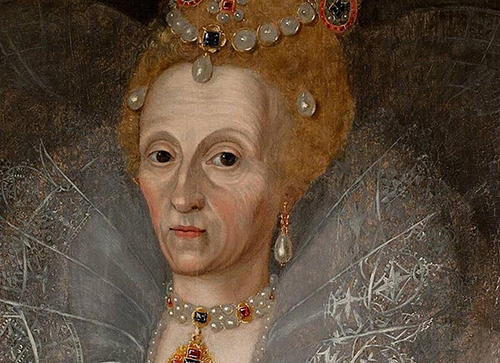
Daughter of Henry VIII and Anne Boleyn, and Queen of England and Ireland from 1558-1603. Though not burned at the stake like the more than 300 men and women who confessed the evangelical faith when her step-sister Mary was queen, Elizabeth was, nonethelss, burnt. In her own reign, therefore, sought to navigate a middle path through the religious reformation in the country, what became known as the 'Elizabethan Settlement'.

Elizabeth I at her coronation
Open Family Tree ☰ (Generation 3)
Both Elizabeth and her half-sister Mary grew up in difficult times. For Elizabeth, her mother was found guilty of adultery and incest and beheaded while she was still an infant. When Mary became queen, Elizabeth was incarcerated in the Tower of London for two years; though reconciled with her sister on a personal level, she maintained her evangelical faith and kept a low profile trying not to get in Mary's way.
When she succeeded Mary to the throne in 1558, she recognized that her subjects were largely Protestant or moving in that direction. Having witnessed the horror of Mary's persecution, she was impatient of religious dogmatism. Extremely intelligent and capable—she spoke fluently French, Latin, and Italian, and knew Greek and Cyprian—she was also confident in her conviction that God's providence had brought her to where she was. In things ecclesiastical she, therefore, sought a middle path wherever things permitted. She reversed almost all of Mary's enactments, and effected what is now called the Elizabethan Settlement, which included the restoration of Henry VIII's ecclesiastical legislation, the Act of Supremacy which then declared the queen to be "supreme of all persons and causes, ecclesiastical as well as civil" (she dropped the "Supreme Head of the Church"), Act of Uniformity accepting the use of the revised Book of Prayer, and enacting the Thirty-Nine Articles (a revision of Edward's forty-two). The Settlement essentially recognized how far the Reformation in the English Church had come but was hesitant to go any further. It created, in the Church of England, "a body sufficiently wide—and ill-defined in specifics—to encompass every shade of orthodox Christian taste, from the High and Catholic to the most plain and earnest Calvinist" (John Macleod).
The early parts of her reign was characterized by the very real problem of being a woman monarch operating in a largely male-dominated world. The fact that she refused to marry (and, therefore stalling the vital question of succession) made her relationship with her counsellors all the more difficult, made worse by the fact that she was not an easy person to deal with. Indecisive, and often regretting what she had decided, she was not above blaming her officers when things go wrong or might look poorly on her—to the point of imprisoning them and forfeiting her favour towards them. At a personal level too, she could be vicious in her jealousies, as evident,e.g., in her treatment of the widow of her favourite—and probably the only man she trully loved—'Rob' Leicester.
Probably the most vexatious of the decisions she had to make was how to deal with Mary Queen of Scots who had agitated long to displace her from the England throne. In the end Elizabeth signed her death warrant and she was executed in 1587. Almost immediately afterwards she was faced with the possibility of invasion by the Spanish Armada. With the counsel and help of many capable people, including the famous Sir Walter Raleigh, she was able to weather the invasion attempt. The last decades of her reign was characterized by relative peace, wealth, and especially, of the arts, so much so a whole category of literature came to called Elizabethan, of which the most famous are the Shakespearean. One often overlooked event was her issue of a charter to the East India Company on the last day of the 15th Century; it would lay the foundation for the eventual domination of the East by the British Empire.

Elizabeth in 1595
She died in 1603, bringing the age of the Tudors to a close, and was succeeded by James VI of Scotland.

TIMELINE:
1533 — 7 Sept - Elizabeth is born.
1558 — 17 Nov - Proclaimed Queen, succeeding Mary I.
1568 — Mary, Queen of Scot, arrives in England, seeking asylum.
1587 — 1 Feb - Elizabeth signs Mary, Queen of Scot's death warrant.
1587 — 19 Apr - Francis Drake makes attack on Cadiz.
1588 — 19 Jul - first ship of the Spanish Armada sighted off the Lizard.

BIBLIOGRAHPY:
The literature on Elizabeth and her reign is voluminous, but see:
Stephen Alford, The Watchers: A Secret History of the Reign of Elizabeth I. London: Allen Lane, 2012.
P. Collinson, Richard Bancroft and Elizabethan Anti-Puritanism. Cambridge: Cambridge University Press, 2013.
John Guy, Elizabeth. The Later Years. New York: Penguin, 2017.
Helen Hackett, Virgin Mother, Maiden Queen London: Palgrave,1995.
P. Lake, Anglicans and Puritans? Presbyterian and English Conformist Thought from Whitgift to Hooker. London: HarperCollins, 1988.
R. Mears, Queenship and Political Discourse in the Elizabethan Realms. Cambridge: Cambridge University Press, 2005.

©ALBERITH
190216lch